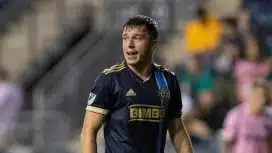Flyers
5 Takeaways from Flyers-Bruins
By Kevin Durso, Sports Talk Philly editor
The Flyers got their first chance to make a first impression on the postseason and boy, did they make a strong one. Opening Round Robin play against the top-seeded Boston Bruins, the Flyers delivered a 4-1 victory on Sunday afternoon.
There were players making their playoff debut, recent additions contributing, depth players stepping up in a big way and an overall defensive effort that completely shut down the powerful top line of the Bruins.
The win did come with a potential cost, but the Flyers depth has been a focal point to their season, and that could come into play again in the coming days.
Here are 5 takeaways from the Flyers win over the Bruins.
1. The Sanheim-Myers Pairing
Throughout the week, both Alain Vigneault and assistant coach Mike Yeo had talked about the confidence they had in placing Travis Sanheim and Phil Myers in tough matchups against some of the league’s best forward lines. While Ivan Provorov and Matt Niskanen continued to do the heavy lifting on the top pairing, Sanheim and Myers showed the potential ceiling of the second pairing and what they can do.
Both Sanheim and Myers contributed offensively — Sanheim assisting on the first goal and Myers scoring the third — but had some key defensive moments. Myers nearly got caught pinching a couple times, but showed his skating ability in his backchecking to even up the rush. Sanheim got in front of a couple of late attempts for the Bruins.
Believe the hype with this pairing. They can be a solid duo with a lot of chemistry and it could last for years.
2. Depth Scoring
Ok, raise your hand if you had the first goal of the Round Robin being scored by Michael Raffl. Now raise your hand if you had a goal being scored by Nate Thompson in this game.
If you had answered yes to both, go buy a lottery ticket. Raffl can bring a scoring touch to a game — he has a 21-goal season to his credit — but Thompson is a rare find on the scoresheet. His role is well defined and he provides the fourth line with a natural center who is solid on face-offs and can play in the trenches.
The point is that this is what good playoff teams get. This wasn’t a game where Sean Couturier and Claude Giroux were doing it all. This was a game against the best team in the NHL during the regular season where two of your fourth-liners scored in the second period to open up a 2-0 lead.
A couple of days earlier, Giroux called this the deepest team he’s ever played on. This performance is showing why he may be right about that.
3. Michael Raffl
Raffl’s contribution offensively was already mentioned, but he’s been a solid two-way player for the Flyers all year. That’s why, no matter what the role, there is no good departure from the lineup. And Raffl had to make his exit late in the game.
Raffl got tangled up with Jeremy Lauzon along the boards and went down awkwardly. Vigneault believed Raffl was slewfooted, and the video does show that motion from Lauzon. While there was certainly no intent, Raffl left the ice without putting any weight on his left leg.
While there was no immediate update on Raffl, and there probably won’t be for a little while, it now brings about the question of who could replace him in the lineup if the injury were to be at least somewhat long-term. The answer is easy. The Flyers had 13 forwards dressed on Tuesday and the odd-man out on Sunday was Joel Farabee. While his style is very different from Raffl, the coaches have loved his tenacity and his energy and he could help out in the bottom six, especially if they are able to generate chances offensively.
4. Laughton Strikes Again
Make it two games in the bubble and two goals for Scott Laughton. One thing the Flyers did a lot of throughout the game was pass up shot opportunities, particularly on odd-man rushes. On their first chance on an odd-man rush in the third, Laughton took the shot and scored.
Many people see Laughton as the prototypical fourth-line center. He’s played the last two games as the second-line wing and it’s easy to see why the Flyers like him there. He is a responsible defensive player to begin with, but many don’t see the scoring touch he brings. He’s got a pretty solid shot, a nod to his junior days when he scored 40 goals in his final season with Oshawa in the OHL.
Laughton is quickly going from depth guy to a key part of the Flyers at both ends of the ice. Now five seasons into his time with the Flyers, he was already proving to be valuable, but he’s becoming one of the team’s leaders.
5. Momentum Swings
The Flyers have played many games against Boston over the years where you feel like the bubble is going to burst at some point. Maybe they have a strong defensive front up and have limited the Bruins for quite some time, but one goal helps open the floodgates.
That feeling was there when Chris Wagner was able to bank a puck off the skate of Robert Hagg and in to get the Bruins on the board with just 1:09 left in the second. That felt like the goal that would break the ice for the Bruins and allow them to get back into the game. Nine seconds later, Myers answered right back.
Not only was that a huge momentum swing for the Flyers, who were able to take their two-goal lead to the third, but it set the tone for the third as well. Sitting on the two-goal lead was not safe against Boston. They needed to keep it going. The Flyers had 12 of the first 13 shots of the third period, including the only goal, and while Boston ended up with 15 shots in the third period, many of them in the final four minutes with the net empty, but it was impressive the way they continued to push for much of the third period, slowly draining away the time Boston had to get back in the game.












































